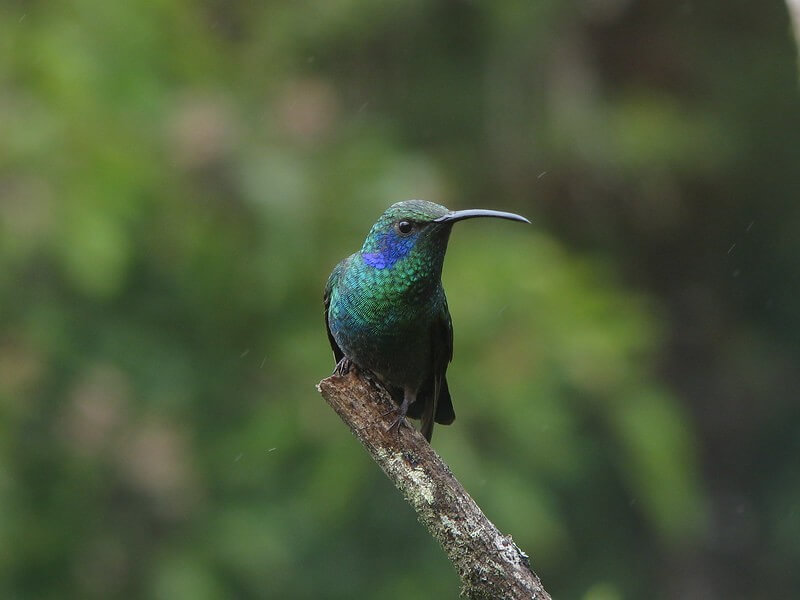Hummingbirds are a beloved sight in West Virginia, with their vibrant colors and cheerful chirps. These tiny birds are a source of joy for many, and they are also a reminder of the beauty of nature. In this article, we will explore the common hummingbirds found in West Virginia, their habitats, and their behaviors. We will also discuss the importance of protecting these birds and their habitats. With the help of local birders and conservationists, we can ensure that these birds will continue to bring joy to West Virginians for years to come. So, let’s take a closer look at the common hummingbirds of West Virginia and learn more about these amazing creatures.
Hummingbirds in West Virginia
Read on to learn more about the 4 hummingbirds that visit West Virginia.
Black-chinned Hummingbird

- Archilochus alexandri
- Size: 3.25″ (8.25 cm)
Identification and Color: A small and slender hummingbird. They have a metallic green head and tail that is not shiny. Males have a black throat with an iridescent purple stripe around it. Females have a paler throat. Has a long, black, narrow bill.
Habitat and Behavior: Found in the western United States and Mexico. Found in various areas like river groves, forests, and semi-arid locations. Males will display during the breeding season by diving steeply in the air. They will dart around flowers and eat insects on vegetation or in the air.
Diet: The Black-chinned Hummingbird enjoys nectar from flowers or hummingbird feeders. Will also eat tiny insects.
What does a Black-chinned Hummingbird sound like?
Black-chinned Hummingbird (Archilochus alexandri) · call, song, wing sound
Thomas G. Graves
Embudo Trail, Albuquerque, Bernalillo County, New Mexico, United States
More Black-chinned Hummingbird Facts
Mexican Violetear

- Colibri thalassinus
- Size: 4.5″ (12 cm)
Identification and Color: Also known as the Green Violetear, they are mostly green hummingbirds. They have green and blue iridescent colorings on their bodies. A blue-purple iridescent patch is found on their cheeks. Wings and tail feathers are darker.
Habitat and Behavior: Found in south-central Mexico and as far south as Panama and Bolivia. They like semi-open highlands with trees or shrubs and prefer humid areas. Will visit the United States but not breed there.
Diet: Nectar is their primary diet, but they may also eat some small insects.
What does a Mexican Violetear sound like?
Mexican Violetear (Colibri thalassinus) · song
Manuel Grosselet
Paz de las Aves, Pichincha, Ecuador
More Mexican Violetear Facts
Ruby-throated Hummingbird

- Archilochus colubris
- Size: 3.5″ (8 cm)
Identification and Color: The Ruby-throated Hummingbird has a brilliant green color on the tops of their heads and bodies and a grey to white underpart. The males have a red throat that can appear dark in poor lighting. A small bird between 2 and 3.5 inches in length. They also have very short wings. A long, slender slightly curved bill.
Habitat and Behavior: In the summer they are found throughout the midwest and the eastern United States but almost all leave for the winter. The Ruby-throated Hummingbird prefers open woodlands, meadows, and gardens. They can fly very fast and will forage from flowers or feeders.
Diet: Mostly nectar from flowers but will eat some small insects.
What does a Ruby-throated Hummingbird sound like?
Ruby-throated Hummingbird (Archilochus colubris) · uncertain
Brian Hendrix
Hendrix Habitat – Fairview, Williamson County, Tennessee, United States
More Ruby-throated Hummingbird Facts
Rufous Hummingbird

- Selasphorus rufus
- Size: 3″ (7.5 cm)
Identification and Color: A smaller hummingbird with short wings, tapered tail feathers, and a straight bill. Males are bright orange with an iridescent red throat and white underparts. Females are green on top with duller orange colors.
Habitat and Behavior: Commonly breed and migrates to the western United States but may also spend winter months in the southeast. Exceptionally fast flyer and will often chase away other hummingbird species from food. Prefers open areas like yards, gardens, or edges of forests.
Diet: Prefers red tube-like flowers for nectar. It also eats tiny insects like spiders.
What does a Rufous Hummingbird sound like?
Rufous Hummingbird (Selasphorus rufus) · call, shuttle display, wing whirr
Eric DeFonso
Twin Spruce Rd area, Jefferson County, Colorado, United State
More Rufous Hummingbird Facts
Conclusion
West Virginia is a state full of natural beauty and wildlife, and hummingbirds are no exception. These tiny birds can be found in many cities across the state, from Morgantown to Charleston, and even in the Appalachian Mountains. They are a reminder of the diverse and unique wildlife that can be found in this region. Hummingbirds are a symbol of the beauty and diversity of West Virginia, and they are a reminder of the importance of preserving and protecting the environment. With the right care and attention, these birds can continue to thrive in West Virginia for many years to come.
Before you go, be sure to check out our other articles about birds in West Virginia.






